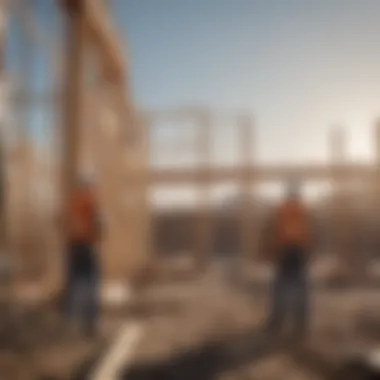Calculating the Rebuild Cost of a Home: A Comprehensive Guide


Intro
In an era where property ownership is often seen as a cornerstone of financial security, understanding the intricacies of rebuild cost becomes essential. Whether you're a long-term homeowner or someone eyeing a potential purchase, knowing how to calculate the rebuild cost of a home is crucial. It’s not just about bricks and mortar; it involves careful consideration of various aspects like materials, labor, and changing local market conditions. This article serves as a comprehensive guide, aiming to equip you with insights that ensure your investments are well protected.
Rebuild cost estimations can feel overwhelming, especially for those not deeply entrenched in real estate. However, breaking it down into manageable sections allows homeowners, prospective buyers, and financial advisors alike to grasp the nuanced factors at play. A failure to accurately assess these costs not only jeopardizes insurance coverage but can also impact your financial stability. So, let’s explore the territory of rebuild costs and uncover the methods and factors that will assist in making informed decisions, ultimately helping you safeguard what is often your most significant investment.
Understanding Rebuild Cost
When navigating the intricate world of home ownership and property value, it’s crucial to grasp the concept of rebuild cost. Understanding this aspect isn't just another line item on your insurance policy; it’s the backbone of effective property management. Rebuild cost refers to the amount of money required to completely reconstruct your home should it be damaged or destroyed. This figure goes beyond mere market value—it’s about the costs tied to actual construction, labor, and materials needed to restore your property as it stands today.
Defining Rebuild Cost
To delve deeper, rebuild cost can be defined as the expenses associated with duplicating a structure. It accounts for various elements, including:
- Materials: The cost of wood, brick, roofing, and other essential components used in building your home.
- Labor: The wages paid to the skilled workers, from carpenters to electricians.
- Additional Fees: This might incorporate permitting, fees for inspections, and other administrative costs tied to constructing a home.
When defining rebuild cost, it’s vital to note that this is not the same as simply taking the market value of your home. Market value is influenced by supply, demand, and an array of other economic factors. In contrast, rebuild cost zeroes in on what it would take to rebuild your home anew—standards and expectations included.
Importance of Accurate Calculations
Undertaking accurate calculations for rebuild cost is not just a minor detail; it's central to securing your property and financial future. Here are several reasons highlighting its importance:
- Insurance Coverage: Knowing the exact rebuild cost helps homeowners choose appropriate insurance coverage. Underinsuring a property can lead to devastating financial consequences if disaster were to strike.
- Financial Planning: Individuals can better plan future investments or renovations when they know what their home is truly worth to rebuild.
- Property Value Insight: Understanding rebuild cost aids in comprehending how fluctuations in material and labor costs can impact overall property value.
"Knowing the rebuild cost is like having a safety net. It ensures that in the event of a mishap, you won't end up in a financial pickle."
In sum, just like one would not drive a car without checking the fuel gauge, navigating the world of property ownership without a thorough understanding of rebuild costs can lead to future headaches. Balancing this knowledge with accurate assessments is essential to creating a safe haven for you and your family.
Methodologies for Calculation
Calculating the rebuild cost of a home isn't a straightforward task. It encompasses various methodologies, each presenting its own set of benefits and considerations. Understanding these methods is vital, as they can strongly influence your financial planning and insurance coverage. By diving into the right methodology, homeowners can better approximate what it would take to restore their property to its original state, ensuring all aspects are accounted for.
Replacement Cost Approach
The replacement cost approach is one of the most commonly used methods for determining rebuild costs. This approach involves estimating what it would cost to replace the home using materials of like kind and quality, without factoring in depreciation. This means you’re looking at the current pricing of materials and labor, rather than what they cost when the home was built.
For example, if your home was built using brick and hardwood floors, the replacement cost approach would estimate how much it costs to replace those specific features today, rather than when they were first installed.
Benefits of the Replacement Cost Approach:
- Accurate Reflection of Current Costs: This method captures the real-time market value of materials and labor, giving a clearer picture of potential rebuild expenses.
- No Depreciation Consideration: As it ignores depreciation, the homeowner gains peace of mind knowing they could ideally return to the same condition after a loss.
Actual Cash Value Method
In contrast to the replacement cost, the actual cash value (ACV) method takes depreciation into account. This method is often used by insurance companies, and it calculates the cost to replace the home minus depreciation. Essentially, it’s the current market value of the home.
This can be somewhat tricky for homeowners, especially if they have invested heavily in renovations or updates. For instance, a ten-year-old roof might not add as much value as one might think, since the ACV would factor in wear and tear.
Key Points about the Actual Cash Value Method:


- Reflects Depreciation: This method might lead to lower payout amounts from insurance due to depreciation.
- Useful for Older Homes: Especially pertinent for older homes where the value might decrease over time.
Square Foot Method
Another widely used methodology is the square foot method. This approach simply entails multiplying the square footage of the home by a predetermined cost per square foot. This cost varies based on regional labor and material prices.
For example, if your home measures 2,000 square feet and the cost per square foot in your area is $150, your estimated rebuild cost would be around $300,000. However, it’s crucial to remember that this is a simplified way of looking at things, as it might not account for unique features or alterations that your specific home might have.
Considerations for the Square Foot Method:
- Quick Estimation: Offers a fast way to get a rough estimate without diving into detailed speculations.
- May Overlook Unique Aspects: Could exclude specific fixtures or additions that could change the costs significantly.
Professional Appraisal Process
For those who wish to leave it to the experts, enlisting a professional appraiser can be the best route. Professional appraisers will conduct a thorough evaluation of your property, taking into account both the current market condition and the details of the property itself.
During this process, an appraiser will consider various factors:
- Local Market Trends: Understanding how neighborhood property values have shifted.
- Property Condition: A detailed inspection of the home’s current state and any overrall items needing repair or replacement.
- Costing of Specific Features: Assessing the rebuild potential of things like custom cabinetry or unique materials.
Advantages of the Professional Appraisal Process:
- Thorough Analysis: Comprehensive evaluation that factors in the intimate details of your home.
- Expert Insight: Access to valuable insights and knowledge regarding local market conditions.
In summary, each methodology presents its own merits and potential shortcomings. Choosing the right method hinges on various factors, like the property’s characteristics and market conditions. Homeowners should weigh these options carefully, perhaps considering a blend of approaches, to ensure a more accurate assessment of their home’s rebuild cost.
Key Factors Influencing Rebuild Costs
When it comes to determining the rebuild cost of a home, several factors come into play. Each of these elements holds significance in shaping the overall estimate, and overlooking any can result in a financial miscalculation that could cost homeowners dearly. It becomes crucial for anyone involved in property ownership or management to firmly grasp these essentials. Here, we will explore the various key factors that can directly affect the rebuild costs of a residential property.
Location and Geographic Considerations
The locality where a home is situated plays a pivotal role in rebuilding costs. Areas that are prone to natural disasters—like hurricanes, earthquakes, or floods—may demand more robust construction materials and methods, increasing rebuild expenses. Similarly, urban areas with a high population density often witness elevated labor costs and logistical challenges due to traffic.
For instance, a home in Los Angeles might require more budgeting for seismic retrofitting compared to one situated in the Midwest. Additionally, the cost of land and local laws can heavily impact the financial outlay needed for rebuilding. Recognizing these geographical nuances can provide homeowners with realistic expectations regarding their rebuild investment.
Building Materials and Quality
Shifting focus to the building materials, one has to consider not just the cost of materials but also their quality. High-end finishes, eco-friendly products, or materials sourced from specialized suppliers can significantly elevate costs. For example, using reclaimed wood or energy-efficient windows might add to the aesthetic and environmental appeal, but they also hike up expenses.
Conversely, opting for affordable materials might lead to lower immediate costs, yet could incur higher long-term expenses through maintenance and replacements. Homeowners ought to balance short-term savings against long-term implications. Quality should not be overlooked, as the choice of materials can determine the longevity of the renovation.
Labor Costs in Different Markets
Labor rates are another major component of the rebuild cost analysis. These costs can fluctuate significantly based on regional economic conditions, demand for skilled labor, and overall market saturation. In some metropolitan areas, skilled labor might command higher wages due to higher living costs, while rural areas might boast lower rates but potentially face a shortage of professionals available to undertake specific tasks.
To illustrate, hiring contractors in New York City is likely to be far pricier than engaging those in a small town in Alabama. Homeowners should do their homework on local labor markets, factoring in these expenses when budgeting for rebuild costs.
Permitting and Regulatory Fees


Lastly, homeowners need to navigate the often-complex web of local permitting and regulatory fees. Depending on the area, getting the necessary permits for rebuilding can prove to be an expensive and time-consuming process. These fees can vary wildly based on jurisdiction, material used, or the intricacies of the planned renovation.
For example, cities with stringent zoning laws might require multiple permits and inspections that escalate costs. It’s prudent for homeowners to contact local authorities to understand these requirements before they begin the rebuilding process. Any unanticipated fee could result in budget blowouts that might derail the entire project.
"Investing time in understanding these factors can save homeowners money and headaches down the line."
In summary, by paying keen attention to these intricacies, homeowners can better prepare for the financial realities of rebuilding. Knowledge of location, material choices, labor markets, and permit processes shapes realistic expectations, guiding decisions that ensure a smoother rebuilding experience.
Tools and Resources for Homeowners
Understanding the rebuild cost of a home is more than just a number; it’s about ensuring your financial future in uncertain times. One pivotal aspect is having the right tools and resources on hand. This section delves into the various options available to homeowners for calculating their rebuild costs, emphasizing the significance of these aids in making informed decisions.
Online Estimation Tools
Online estimation tools have transformed how homeowners approach rebuild cost analysis. These platforms offer convenience and immediacy, allowing users to plug in specific details about their homes. This may include square footage, the materials used, and, importantly, local construction costs.
The beauty of such tools lies in their accessibility—most are free or low-cost, which is a bonus for budgets that are already stretched thin. They often present the information in a clear and concise manner, making it easier for the average homeowner to understand. However, it’s essential to keep in mind that while these tools provide a good starting point, they might not account for unique features of your home, like custom finishes or local labor variations.
A few well-known online tools include Zillow's Home Value tool, which gives estimates based not solely on real estate data but also on rebuilding figures. Although they are useful, homeowners should use these as rough estimates rather than definitive costs.
Consulting with Insurance Agents
Your insurance agent can be a veritable treasure trove of knowledge when it comes to understanding rebuild costs. They are familiar with the specific market conditions and can guide you through the nuances of coverage options. Consulting with an insurance agent should be viewed not merely as a formality but as a proactive strategy for safeguarding your investment.
When discussing with your agent, be prepared to ask targeted questions about your policy. For instance, inquire about coverage limits or whether it includes additional living expenses in the event of a disaster. This can provide insights into how your rebuild costs align with insurance coverage, ensuring that you’re adequately protected.
One of the significant advantages of consulting an insurance agent is their ability to provide tailored advice based on your unique situation. With their experience, they can illuminate potential pitfalls or clauses in policies that might otherwise be overlooked.
Hiring Professional Assessors
While self-assessment tools and insurance consultations are beneficial, sometimes, you need a more definitive answer. That’s where hiring professional assessors comes into play. These experts come equipped with industry knowledge and experience that can make a world of difference when estimating rebuild costs.
Professional assessors can provide a comprehensive evaluation of your property, taking into account the unique architectural features, building materials, and current market dynamics. They usually offer a detailed report that can serve not just for insurance purposes but also for refinancing or selling your home.
When looking at costs, be mindful that hiring a professional might seem like a significant expense upfront, but in a pinch, this investment pays off by providing accurate and reliable data. Moreover, an assessor can help identify any hidden issues that could unexpectedly inflate your rebuild cost later on.
In summary, these tools and resources are invaluable for homeowners wanting to approach rebuild cost calculations methodically. Utilizing online tools for immediacy, consulting with seasoned insurance agents for tailored advice, and hiring professional assessors for accuracy can significantly influence the peace of mind in managing your property investment. It’s clear that a robust strategy requires leveraging all available resources to ensure that your home’s value is protected.
Common Misconceptions
When it comes to determining the rebuild cost of a home, there’s a minefield of misconceptions that can trip people up. Grasping the true nature of these misunderstandings is vital for anyone looking to safeguard their property. Myriads of homeowners believe they have a handle on what these costs entail, yet often fall prey to fallacies that can lead to major financial repercussions. Let’s dig into some of the most prevalent myths surrounding rebuild costs and dispel them for good.
Misunderstanding Insurance Coverage
Insurance is a safety net, right? Still, many homeowners take it for granted, not fully understanding the ins and outs of their policies. A frequent error occurs when people assume their homeowner's insurance provides coverage for the full rebuild cost of their home. In reality, there are various factors that contribute to the amount you receive after a calamity.
For example, if your home is assessed at a market value of $300,000, that doesn’t necessarily mean you’re insured for that much. Insurance typically considers numerous elements, such as depreciation value, to determine the payout in the event of damage. Therefore, if your policy only covers actual cash value, you might be left holding the bag when it comes time to rebuild.
Furthermore, understanding the difference between replacement cost coverage and actual cash value is crucial. Not knowing this could lead to budget shortfalls during a rebuilding process, because it’s about more than just replacing bricks and mortar. Also, often overlooked are additional living expenses while your home is being rebuilt, which, if inadequately insured, could strain your finances significantly.


Assuming Replacement Cost Equals Market Value
This may sound quite familiar – the idea that the replacement cost of a home is synonymous with its market value. However, let’s clear the air: these two concepts are as different as night and day. Market value reflects what a buyer is willing to pay for your home in its current condition, influenced by various elements such as local demand, amenities, and neighborhood desirability. Replacement cost, on the other hand, pertains to what it would cost to rebuild your home from the ground up, factoring in current materials and labor prices.
According to reports, a common pitfall for homeowners lies in their underestimation of construction costs. A theoretical rebuild of an older structure, for instance, might require much more resources than what the market dictates. Consider checking local contractor rates or consulting with professionals to understand the nuances thoroughly.
"Not all homes are created equal! It's best to sort out your actual replacement costs before relying on market assessments."
Overlooking Upgrades and Renovations
Many forget that upgrades and renovations can dramatically shift the rebuild cost estimation. You might think that a basic structure is easy to replace, yet if high-end materials were used in renovations, these details mustn’t be ignored when calculating rebuild costs.
For instance, if you’ve spent a pretty penny on premium flooring or energy-efficient systems, you cannot simply revert to the costs of more basic materials. By failing to account for these enhancements, homeowners could be severely underprepared financially in the event of loss or damage.
So, keeping a detailed record of all improvements is key. Not only does it streamline calculations during insurance assessments, but it also aids appraisers when determining the value of your property.
In summary, getting a handle on misconceptions about rebuild costs can not only save you from projectile bills later down the road but also pave the way for smarter insurance planning. Awareness and regular reviews of your home's specifics can go a long way in the rocky landscape of property management. Stay informed to protect your investment—it just might save your financial skin.
Evaluating Your Home’s Rebuild Cost Periodically
Evaluating your home’s rebuild cost is not a one-and-done affair. On the contrary, it's vital to assess this figure periodically for several reasons. First and foremost, rebuild cost can fluctuate over time based on various factors such as changes in material prices, labor costs, and local regulations. Moreover, neglecting to keep this figure current can lead to significant financial repercussions, especially when disaster strikes.
Keeping your rebuild costs up-to-date ensures that you are adequately covered by your insurance policy. Knowing the exact amount needed to rebuild can save you from scrambling later, particularly in a crisis. It provides peace of mind, allowing homeowners to rest easy, confident their investments are safeguarded.
Setting a Timeline for Reassessments
Establishing a clear timeline for reassessing your home’s rebuild cost can prevent unexpected surprises. Consider setting a schedule, perhaps on an annual basis, to review and adjust the calculation. This timeframe aligns well with home maintenance routines, making it easier to stay organized. Additionally, your local real estate market trends and inflation could shift; hence regular evaluations ensure these factors are reflected in your rebuild calculation.
It’s also advisable to document all home improvements or upgrades made during the year. Having a solid record allows for easy adjustments during reassessments. Whether it’s a new roof, upgraded kitchen, or additional rooms, you want to make sure these changes are accounted for to provide precise coverage.
When Major Changes Occur
Major changes to your home can substantially affect your rebuild cost. Anytime you undertake significant renovations or repairs, it’s wise to reassess your previous calculations. For instance, if you've finished your basement or added a deck, these alterations will likely increase the cost of rebuilding your home in the event of a loss.
Additionally, external factors such as shifts in the housing market or local zoning laws might impact your rebuild cost. If a natural disaster strikes your region, you may notice spikes in building material prices, prompting an immediate review of your figures.
In essence, flexibility is key. Staying alert to the current conditions in your location and willing to adjust your rebuild cost accordingly will ensure that you’re not left in the lurch. This blend of proactive and reactive evaluation brings a level of security and preparedness that every homeowner should prioritize.
"A house is not merely a structure; it’s an investment that deserves constant vigilance in its valuation."
With a conscious effort to evaluate periodically, homeowners can navigate the complexities of rebuild costs more effectively, ensuring they are always in the right position to bounce back from any unforeseen challenges.
Ending
When it comes to managing a property, accurately determining its rebuild cost is a cornerstone issue that cannot be overlooked. Throughout this article, we've explored various methodologies, factors, and key considerations that come into play when calculating this important figure. The significance of masterfully grasping your home’s rebuild cost extends beyond mere numbers; it fundamentally impacts your insurance decisions and ultimately, your financial security.
Understanding rebuild cost helps homeowners like yourself to navigate the tumultuous waters of property management. It’s about getting a grip on what you would truly need to rebuild in case of disaster, ensuring you have optimal coverage through your insurance. If you miscalculate, you could be stuck with shockingly high out-of-pocket costs after a loss.
In such a dynamic landscape where economic fluctuations influence material and labor costs, staying informed about your home’s rebuild cost is vital. Regular assessments can also buffer against market volatility, giving you a grounded sense of financial stability.
Homeowners often find comfort in knowing they have a comprehensive insurance plan in place; however, its success hinges on accurate rebuild cost calculations. Remember, the work doesn't stop after an initial estimate. Home renovations, legal changes regarding constructions, or shifts in local economic conditions can and will affect costs. Therefore, staying proactive ensures you won't find yourself underprepared.
"Proactive planning is the best way to safeguard your investment and peace of mind."
By following the guidelines laid out here, engaging with professionals when necessary, and frequently revisiting your calculations, you equip yourself with necessary tools for adept financial management. Furthermore, an informed homeowner is a confident one—having the right information at your disposal empowers you to make decisions that positively impact your family’s future.
In summary, the journey to understanding rebuild costs may seem overwhelming at first, but the benefits of clarity far outweigh the effort. As you move forward, keep in mind that knowledge is power: an informed approach to your home’s rebuild cost can lead to better planning, protecting your family and investing wisely in your future.



